Nothing Phone (1) review: Design, build quality, handling
Design, build quality, handling
The Nothing Phone (1), being the company's first smartphone, had to make an impression, and it had to make it right. The expectations for the design were particularly high, and we are happy that Nothing indeed succeeded in making an outstanding first impression!
Nothing Phone (1) has two signature bits that will probably remain for at least a few generations - the see-through rear glass and the Glyph LEDs under that glass.
Besides the unique looking back panel, the Phone (1) features the usual high-quality build of two flat Gorilla Glass 5 pieces and an aluminum frame and chassis in-between. The whole thing is IP53-rated for dust and light splash resistance. It would have been nicer to get complete water protection, IP67-rated or more, but it is what it is. After all, we are not looking at a flagship here.

The Nothing Phone (1) is available in either Black or White colorways, and we have them both. The main difference is obviously the design of the backside. The frame on both variants has a matte finish and is painted dark gray.

And speaking about the frame, it's incredibly flat, and the Phone (1) can stand on its own, like some iPhones. It's not an achievement of any importance, but it speaks well for the overall balance of the device's design.
Starting with the front, we can see that the Phone (1) has more than a passing resemblance to modern OLED iPhones. The Gorilla Glass 5 is completely flat and perfectly flush with the frame. The bezels around the display are uniform, and Nothing is using the same flexible OLED tech that Apple uses to curve the display controller under itself in order to reduce the size of the bottom bezel. The only real difference is the presence of a hole punch camera in the top left instead of Apple's infamous notch.

Nothing has used an optical fingerprint scanner placed under the display. It's about 1cm away from the bottom, a bit lower than on most phones, but we found its placement comfortable. Plus, the scanner is always-on and offers notably good speed and accuracy.

Above the screen, right next to the top part of the frame, you can spot a small outlet with a barely visible grille. This is where one of the stereo speakers, also acting as an earpiece, goes. An actual proximity sensor is hidden within the black bezels, so you don't have to worry about mistouches during calls.

The back is where things get interesting. A transparent Gorilla Glass 5 panel covers the entire surface, giving a view of some of the components. It also lets the Glyph Interface lights shine through.

Of course, the clear design is mostly window dressing. You don't actually get to see the phone's internals because most of it is hidden behind plastic covers. The only identifiable components visible are the induction coil for the two-way wireless charging and a ribbon cable, presumably for the battery.
If you were expecting to see actual components like motherboard, battery, and speaker, you might end up disappointed, though. What you get is a sea of oddly shaped bits and pieces.

The black version looks more subdued, while the white model looks busier and somewhat flashier. Both have a certain charm to them; you just need to pick the one that you like better.
The only practical reason for the back to be transparent is for the Glyph Interface lights to shine through. These four sets of LEDs can be controlled through the software (more on that later) and are essentially used to indicate calls, notifications, and charging status. They can also be used as a fill light for the camera.
The LEDs can get extremely bright, to the point where we don't recommend keeping the phone near your eyes when they are about to light up. Their color is somewhat inconsistent, and there is some yellowing noticeable on some of the strips. However, this is not usually noticeable as they normally blink very rapidly.
And something you won't see right away is a small red LED that can flash while you are capturing videos. It's turned off by default from within the Camera app.

The Glyph is unique and useful; no two ways about that. But, to get any value out of it, you have to be someone who puts their phone face down, which is not something most of us do often. With the advent of always-on displays, there really is no reason to put your phone face down, as you'd miss out on quite a lot of useful information. With AOD, you get up-to-date information on all incoming calls and notifications whereas the lights on the back can only really identify a certain caller using custom ringtones but are otherwise quite vague as a notification system.

We do admit it's cool to wirelessly charge headphones or smartwhatches, or simply charge the Phone (1) and enjoy the slowly increasing battery indicator. The different notification Glyph patterns are cool, too. But for that, you will have to completely change your habits. And probably leave the factory screen protector on or even apply a higher-grade one.

There are two jutting-put metal rings on the back - each circling a 50MP camera. The top one is ultrawide, while the bottom one is the primary wide-angle camera with OIS. A single LED flash is also around. The Nothing Phone (1) is wobbling a bit on a table because of that, but not as much as many recent phones. Though, since you are supposed to keep it lying on its face, that will hardly be an issue, right?

The sides of the Nothing Phone (1) also remind us of the regular iPhone models. They are completely flat, while the power and volume buttons are split across them in a similar fashion. We would have appreciated it if Nothing had gone all the way and also borrowed the alert slider, coincidentally also found on OnePlus phones.

And there is the power/lock key on the right side.

The top of the phone houses a lonely microphone, one of three actually. Another one sits next to the dual camera on the back, and the primary one is at the bottom, next to the USB-C port.

The bottom is also where you'd find the dual-SIM tray and the second stereo speaker.

In terms of usability, the Nothing Phone (1) is quite large, almost as much as the iPhone 13 Pro Max. This, coupled with the flat sides, does make the phone awkward to use if you are used to smaller phones.
The build quality of the Phone (1) is solid. The glass and aluminum surface feels premium, and things like panel gap tolerances are very tight. The buttons on the side feel firm and have good tactile feedback. Another positive thing we found is the incredibly easy-to-clean glass panels - a single wipe is enough to bring them back to pristine condition. Even better, fingerprints and smudges are not as easy to stick as on other phones. We'd go and throw a wide guess that maybe the Phone (1), just like the iPhones, comes with oleophobic coating.

The Phone (1) also has IP53 rating for dust and water resistance, which is somewhat of a bare minimum as far as IP ratings.
Overall, we credit the Nothing Phone (1) for being interesting and standing out from the sea of black and gray phones on the market. Some can argue it would have been cooler if we had a look at the actual insides of the phone instead of this prettied up, sanitized version.
But complete transparency could have costed the beauty of the Glyph UI, which needs all the attention it can get as its coolness and usability may fade rather fast.

Long story short - the Nothing Phone (1) marks the beginning of a brand-new series of devices, and it does it the right way. Only time will tell if Glyph leaves a mark in the history books, but as a phone - this device has a solid, no-nonsense build with a premium touch that is easy to like right out of the box
Display
The Nothing Phone (1) employs a 6.55-inch OLED of premium quality - it offers 10-bit color depth and can display up to 1B of colors; there is 120Hz refresh rate, 240Hz touch rate, and HDR10+ support. The resolution is the traditional extended 1080p resulting in a sharp 402ppi density.The panel has a small perforation around its top left corner to make way for the selfie camera. Gorilla Glass 5 piece is responsible for the protection, while the phone also ships with a thin but of premium quality pre-applied film for extra scratch-protection.

The Nothing's official page mentions 500 nits of typical brightness and up to 1200 nits of peak brightness. Our display measurements captured 462 nits of typical (manual) brightness and 663 nits of maximum (auto) brightness.
The minimum brightness at point white was just 2 nits - on par with most of the OLEDs these days and considered an excellent one.
| Display test | 100% brightness | ||
| Black, | White, | ||
| 0 | 466 | ∞ | |
| 0 | 663 | ∞ | |
| 0 | 383 | ∞ | |
| 0 | 800 | ∞ | |
| 0 | 507 | ∞ | |
| 0 | 824 | ∞ | |
| 0 | 437 | ∞ | |
| 0 | 634 | ∞ | |
| 0 | 427 | ∞ | |
| 0 | 830 | ∞ | |
| 0 | 438 | ∞ | |
| 0 | 633 | ∞ | |
| 0 | 468 | ∞ | |
| 0 | 761 | ∞ | |
| 0 | 530 | ∞ | |
| 0 | 1003 | ∞ | |
| 0 | 852 | ∞ | |
| 0 | 1050 | ∞ | |
| 0 | 468 | ∞ | |
| 0 | 782 | ∞ | |
| 0 | 1214 | ∞ | |
Color accuracy
The display on the Nothing Phone (1) supports DCI-P3 wide color gamut. The phone's settings offer two different color modes - Alive (default, DCI-P3) and Standard (sRGB). You can adjust the color temperature for each mode.The default setting is Alive, and it is tuned to reproduce DCI-P3 faithfully - we found the screen to be of excellent accuracy to DCI-P3 (average deltaE of 1.9). The Standard mode also offers an outstanding accuracy to sRGB (average deltaE of 1.5).
Refresh rate
There are two Refresh Rate modes - High (120Hz) and Standard (60Hz).When using the High setting, the screen uses 120Hz throughout the UI and all system apps, but it reverts to 60Hz on most occasions when the picture is static for battery-saving reasons. 60Hz is often used for video playback/streaming and across apps that cannot support higher than 60Hz screens.


Refresh rate • Colors
Hardware screening apps recognize the screen as capable of 60Hz, 90Hz, and 120Hz fixed refresh rate steps. The only occasions we found the phone to be using 90Hz was across some menus (instead of 60Hz), and when playing video previews or in video pop-up windows.
High refresh rate gaming seems possible on the Nothing Phone (1), and we saw a few games using the 120Hz refresh rate as native.
HDR and streaming
The Nothing Phone (1) screen supports HDR10 and HDR10+. The phone also supports Widevine L1 DRM, which means it is ready to serve the highest streaming quality, in its case, 1080p HDR10.
The Phone (1) is supported by popular streaming apps like Netflix and will serve the highest resolution available for streaming quality. Unfortunately, at launch, only YouTube supports HDR streaming. We are hopeful apps like Prime and Netflix will certify the phone soon enough, too.
Haptic feedback
Finally, we want to praise the screen's haptic feedback - it is among the best we've used, with lovely haptics you can feel at the exact spot where you've tapped.Battery life
The Nothing Phone (1) is powered by a 4,500mAh battery - the same capacity as the Galaxy A52s and Poco F4. It can be recharged via Power Delivery chargers up to 33W.
The Nothing Phone (1) scored a 108h endurance rating. It aced all three tests - calls, web browsing and video playback. The only average component here was the standby.
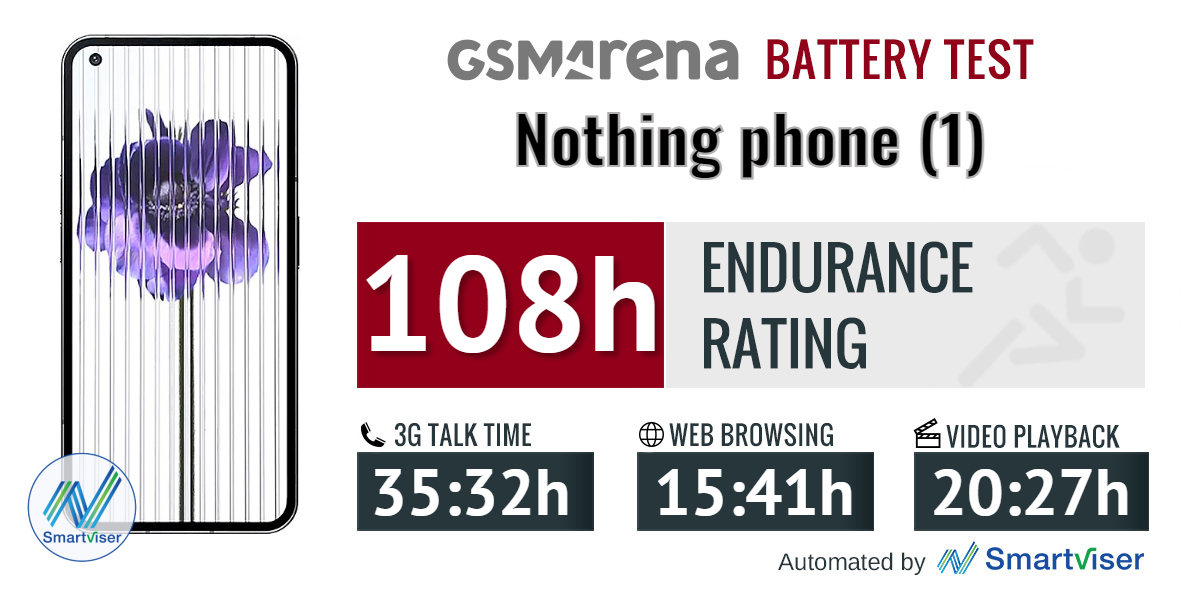
Our battery tests were automated thanks to SmartViser, using its viSerDevice app. The endurance rating denotes how long the battery charge will last you if you use the device for an hour of telephony, web browsing, and video playback daily. More details can be found here.Because of the average standby performance, the Nothing Phone (1) got a slightly lower endurance rating than other competitors.
Video test carried out in 60Hz refresh rate mode. Web browsing test is done at the display's highest refresh rate whenever possible. Refer to the respective reviews for specifics. To adjust the endurance rating formula to match your own usage patterns, check out our all-time battery test results chart where you can also find all phones we've tested.
Charging
The Nothing Phone (1) supports up to 33W fast wired charging, and it can be achieved with any USB-PD 3.0 charger available on the market. Nothing cites 50% of charge in 30 minutes with such a charger, and we can confirm that.
We used a 65W Baseus charger, and it refilled 48% of the Nothing Phone (1) battery in half an hour.30min charging test (from 0%)Higher is better
A full charge required 91 minutes, with the Phone (1) noticeably slowing the charging speed after reaching 80%-90%.Time to full charge (from 0%)
Lower is better
The Phone (1) also supports 15W wireless charging, and you can even wirelessly reverse charge devices on its back.
Well, we tried it, and it does work as advertised. You just need to enable Battery Share from within the battery settings.
Speakers
The Nothing Phone (1) offers a stereo speaker setup of the hybrid type. There is a full-blown speaker at the bottom of the phone, while the earpiece acts as a second, front-facing speaker.
The earpiece is noticeably quieter and lacks bass, unlike the rather loud and bassy bottom speaker. On the other hand, when both are playing music together - they do sound balanced well enough, especially for landscape viewing purposes.
We noticed an odd issue with the speakers, one that we hope Nothing fixes with an upcoming update. The speakers' channels are locked - the earpiece plays left, the bottom plays right - and unfortunately, they won't swap if you rotate the phone.
The Nothing Phone (1) speakers scored a Very Good mark on our loudness test. On the other hand, the sound quality is merely average - the setup plays high tones well, but its mid-tones and bass are notably weak.

Use the Playback controls to listen to the phone sample recordings (best use headphones). We measure the average loudness of the speakers in LUFS. A lower absolute value means a louder sound. A look at the frequency response chart will tell you how far off the ideal "0db" flat line is the reproduction of the bass, treble, and mid frequencies. You can add more phones to compare how they differ. The scores and ratings are not comparable with our older loudspeaker test. Learn more about how we test here.
Audio quality
It's been a while since we've done this chapter - we discontinued the test in early 2020 because phones became so good that the differences between them could only be detected with lab equipment and didn't really matter in real life.But the Nothing Phone (1) forced us to do some digging as none of the headphones - wired and wireless - sounded right when connected to it. So we dusted off our trusty old test tool and ran the Phone (1) through it to confirm our suspicions.
And indeed, the Phone (1) has a disastrous frequency response - you can see a comparison to the Poco F4's frequency response below.
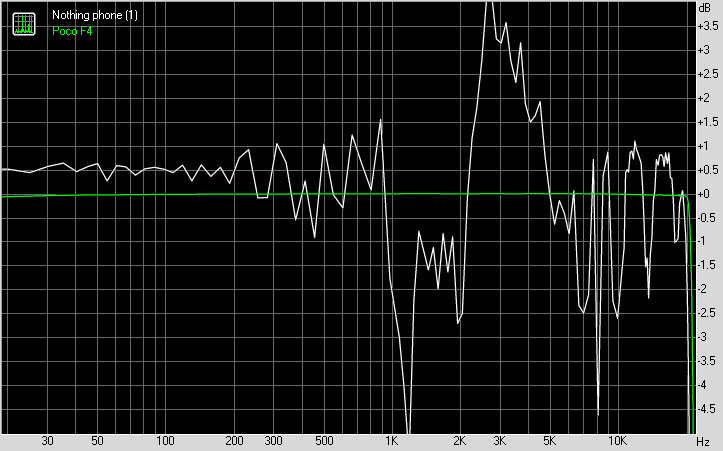
And it's not the only issue either - stereo crosstalk is so high (-3.9dB compared to -85dB or lower for just about every phone) that the phone's stereo effect is severely compromised.
Normally, poor frequency response would point to an equalizer applied, but in this case, it's so shaky that if that's indeed the case, this equalizer must be very, very badly tuned. And even if it existed, there is no option for switching it off, so we are more inclined to believe that the company just generally messed up the software in this part. We certainly hope a fix is coming soon because until then, the audio experience will be severely compromised. Not great prospects for a company whose first product was audio related.
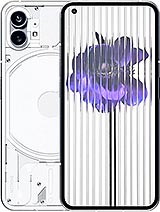
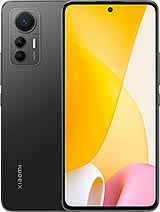
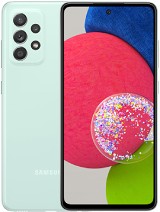
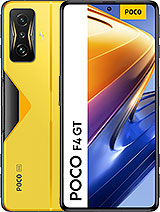

Comments
Post a Comment